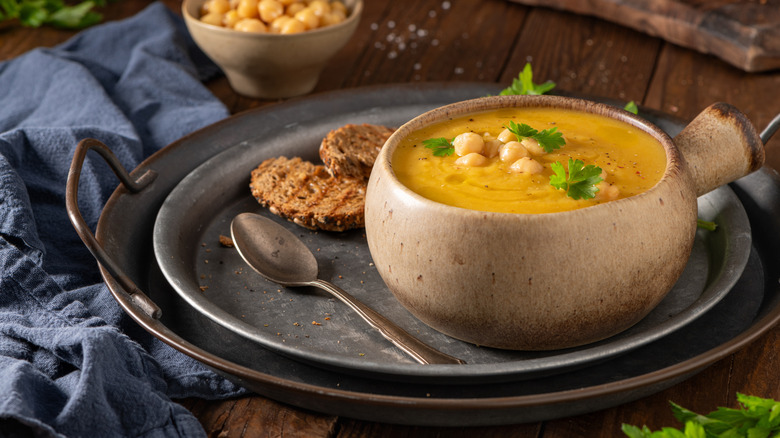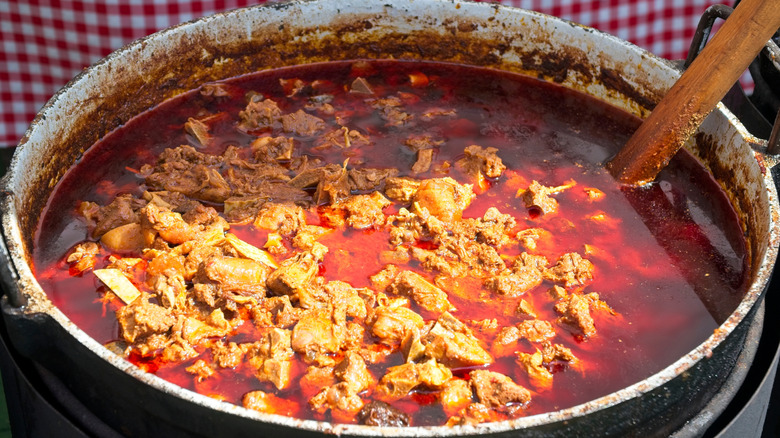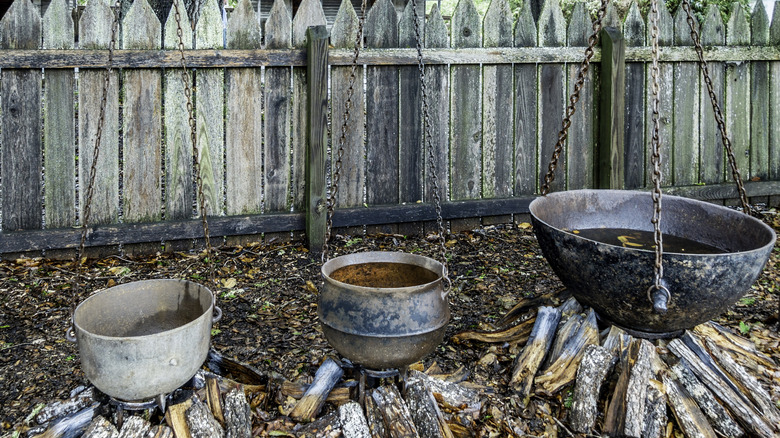
AnaMarques/Shutterstock
We may receive a commission on purchases made from links.
Soup is one of the most universally eaten foods on the planet. It's also very old. Historians have suggested that soup-making is a practice that dates back to the Stone Age, some 25,000 years ago. Archeological findings have led experts to believe that once primitive humans discovered fire, they likely started making soup — or at least stews and oatmeal mush. There are definitely some ancient soups that you won't see a lot of people eating today, but some more recent ones have also fallen by the wayside.
Many soups that we might consider outdated in the U.S. are actually eaten pretty widely elsewhere. Old-fashioned soup ingredients like blood broth are still commonly incorporated into soups in Europe. Similarly, taboo ingredients like horse meat, beaver tail, shark fin, and whale continue to have a place in other cultures. To that end, what actually makes a soup obscure?
Several of the soups we'll look at here were made out of necessity rather than predilection. When times were tough, ingredients became scarce, and people had to get resourceful. One of the beauties of soup is that it can feed a crowd without breaking the bank. It's also a forgiving format that allows for a melange of regional and seasonal ingredients to blend together, and with some well-intentioned seasoning, these makeshift recipes could be really tasty. Soup itself has stood the test of time, but you probably won't find these old-school creations on the table anytime soon.
Melas Zomos (aka black soup)
Few soups are as old school or as brutal as Melas Zomos. Also called black soup, Melas Zomos was the signature soup of the Spartans — the hardcore, bloodthirsty warriors of Ancient Greece. They were bloodthirsty indeed. When the Spartans weren't shredding up the battlefield they were eating communal meals of Melas Zomos, a soup of boiled pork, fresh blood, vinegar, and salt or spices. The vinegar likely served as an anticoagulant to the blood.
If this doesn't sound appealing, well, it wasn't meant to be. The Spartans ate for strength and sustenance rather than taste. Much of the lore surrounding Melas Zomos has been derived from the writings of the Greek historians Herodotus and Plutarch. One famous anecdote about Melas Zomos involved a man from the ancient city of Sybaris visiting a Spartan mess hall (known as a syssitia). Sybarites were known for their self-indulgence and penchant for luxury, so when the man tasted the Melas Zomos in the syssitia, he said, "Now I know why the Spartans do not fear death."
If Melas Zomos is made today, it's usually done as an experimental homage to Spartan life. That doesn't mean soups with blood as an ingredient have vanished from society. Dinuguan (pig's blood stew) in the Philippines, czernina (duck blood soup) in Poland, and seonjitguk (clotted cow's blood soup) in Korea are just a few of the customary blood broth soups that are still part of the global conversation.
Squirrel stew
In some parts of the U.S. skinning and stewing squirrels is still part of the local menu, but in times past eating squirrel stew was a way of life. Squirrel stew is a quintessential product of the "make good of what nature gave you" ethos behind wild game hunting, and by the 19th century, it was being featured in regional cookbooks in the South. Until 1996, reprints of 1931's "Joy of Cooking," the seminal cookbook by Irma Rombauer, included squirrel recipes. More recently, squirrel stew hasn't been able to hold much mainstream attention.
America's early settlers relied on squirrel stew as a source of nourishment. Hunting and skinning squirrels wasn't as taxing as taking on larger game, so many families made squirrels a regular part of their diet. A pot of slow-cooked squirrel with vegetables, broth, and a little seasoning made for a simple and filling meal.
Squirrel stew's old-time rustic comfort made it a favorite food of U.S. Presidents William Henry Harrison and James A. Garfield. Ninth President William Henry Harrison (who died 31 days into his presidency) grew up in Virginia and was known to go in on some squirrel stew from time to time. James A. Garfield, the 20th president, grew up in rural Ohio and was such a fan of squirrel soup, his recipe was included in the "Original White House Cook Book" in 1887.
Dandelion soup
If you've looked at a bunch of dandelions as more of a nuisance to your lawn and less like a soup ingredient, you're not alone. Yet back in the day, people didn't dump weed killer on dandelions, they ate them. Dandelion soup is definitely a throwback. Recipes dating back to 1910 are still kicking around, though the soup's origins are much older. Indigenous people throughout the world have been growing dandelions for food and medicinal purposes since the 10th century.
In Germany, a green soup called Gründonnerstagsuppe, containing seven or nine herbs including dandelion, parsley, leek, daisies, and spinach is a longstanding culinary tradition of the religious holiday Maundy Thursday, or Holy Thursday. Italians don't relegate their love of dandelion soup to annual occasions. Bitter dandelion greens were both foraged and harvested in Italy for centuries. A peasant-style soup known as "minestra maritata," meaning marriage soup, was named as such because it married dandelion greens and other leafy vegetables with meat (traditionally pork). Minestra maritata was a prototype for what would later evolve into Italian Wedding Soup.
Italians who emigrated to America in the mid to late 19th century took their fondness of dandelion soup with them. One historic Italian-American with a soft spot for dandelion soup was Al Capone. "Uncle Al Capone," a book written by the notorious gangster's niece, Deirdre Marie Capone, shares a recipe for dandelion soup that Al Capone particularly loved.
Hot dog soup
When the American stock market crashed on October 24, 1929, a day known as "Black Thursday," it was a dark omen for life in the 1930s. The crash of '29 ushered in the Great Depression, a time when Americans were forced to be resilient, resourceful, and incredibly frugal. Great Depression-era recipes are some of the truest testaments to how hard life had gotten in those days. One such recipe was hot dog soup, and it's not around much anymore.
The hot dog soup of the 1930s went by more than one name. In the early stages of the Great Depression, 31st President Herbert Hoover was blamed for much of the economic turmoil that had befallen U.S. residents. When people lost their homes and erected shack-like encampments at the city's edge, they became known as "Hoovervilles." Similarly, the first recipes for hot dog soup were called "Hoover Stew." The soup was made from canned vegetables, sliced hot dogs, and pasta noodles. It was commonly served in soup kitchens and Hoovervilles — places where meals needed to stretch as far as they could go.
When Hoover Stew first came about, hot dogs were a chosen meat source due to their affordability. In the 1950s, when the Great Depression was a bad memory of the not-so-distant past, hot dogs were still a popular household food, and hot dog soup was still prepared. Hot dog soup recipes from the 1950s featured more decadent ingredients like butter, cheese, and Worcestershire sauce.
Turtle soup
Sure, turtle soup sounds weird at first mention, but it's a delicacy that has substantial roots in the U.S. and beyond. For America's part, turtle soup, also called terrapin stew, is a regional food of a bygone era. Back in the 18th and 19th centuries, turtle hunting, and the feasts that were held afterward, known as "turtle frolics" in the American South, were a really big deal. Within the last 50 years, turtle hunting in the South has been downsized to little more than a niche pastime. By the early 1900s, large green turtles and their smaller counterpart, terrapins, were over hunted to the point of near-extinction.
The restaurants that serve turtle soup are equally specialized. Oyster House in Philadelphia and Commander's Palace in New Orleans are notable institutions that offer this old-school soup on their permanent menus. New Orleans, in particular, has made an effort to keep the legend of turtle soup alive as part of the city's rich Creole tradition. Centuries ago, New Orleans' famous gumbo was made using turtle stock. Modern day turtle soup incorporates meat from the snapping turtle.
In the 20th century, canned mock turtle soup also had a moment. The mock turtle meat was made from calf's head, which was thought to mimic the texture and flavor of genuine turtle. Campbell's made a mock turtle soup, but discontinued it sometime before 1960. Today, one of the only canned turtle soups still sold is from a brand called Worthmore.
Cabbage soup
To those of you whose babcia's and babushka's make cabbage soup on the regular, those precious Eastern European recipes aren't the kind of cabbage soup we mean. Back in Medieval times, clear-broth cabbage soup was a go-to recipe for the cold weather months, when the only produce available was what could be stored through the winter. Cabbage is a hardy vegetable that can last for months if it's stored efficiently. Cabbage was also affordable, making it accessible even to those of meager means.
A preserved recipe from 1450 for Cabochis calls for parboiled, chopped cabbage to be boiled in a pot with fresh broth and marrow bones, then finished with grated bread, salt, and a pinch of saffron. Fast-forward to the 1940s, and cabbage soups looked and tasted a little different. Some recipes called for milk, cooking fat, oatmeal, or all three. Neither of these types of cabbage soups are regulars at the table anymore.
Cabbage soup's last foray into widespread popularity was in the form of a 1980s fad diet. The Cabbage Soup Diet was essentially a crash diet that involved eating little more than cabbage soup for every meal for a week straight. The diet's lure of helping people lose 10 pounds in seven days caught on — for a while. A quick browse on social media will show that cabbage soup as a diet food hasn't disappeared completely, yet its mainstream popularity on the health and wellness circuit has dwindled.
Zirbaja
Ancient Mesopotamians didn't have the internet nor cookbooks to keep track of their favorite recipes. That wasn't going to stop them from documenting the ingredients in their favorite dishes. Archeological digs in what was formerly Mesopotamia (modern day Iraq), the early 1980s unearthed four clay tablets engraved with writing. A team of historians were able to decode enough of the engravings to understand that they pertained to cooking food. Experts in Mesopotamian history say that much of what was eaten in the archaic civilization were soups and stews. One of these stews was zirbaja.
Also called zīrbāj, zirbaja was so popular in Abbasid cuisine it was part of a plotline in "Arabian Nights." The Abbasid dynasty ruled over Baghdad from 750 to 1258. The stew consists of chicken, almonds, and saffron, however, modifications were made over time. One recipe from a 10th century cookbook calls for a green sauce made from crushed parsley, rue (a bitter evergreen), and pistachios. Commonly used spices in zirbaja and other traditional dishes of the time period were coriander, pepper, and cassia, or dar sini (also referred to as Chinese cinnamon).
Zirbaja isn't well-known throughout the globe, but efforts are being made to change that. This old-school soup and several other ancient dishes of the fertile crescent are stepping into the limelight thanks to historian Nawal Nasrallah who wrote the cookbook "Delights from the Garden of Eden." There were also recent culinary efforts by Bahraini chef Tala Bashmi to modernize zirbaja in the fine dining space.
Mutton stew

csikiphoto/Shutterstock
Once upon a time, cultures all over the world were slurping up mutton stew. In England, a thick stew of ground mutton was part of the 16th century royal diet. A traditional Irish version contained hunks of mutton (or bone-in meat), onions, potatoes, and barley. Birkagulyás is a Hungarian mutton stew full of veggies and seasoned with paprika. The Javanese region of Indonesia gave us tongseng kambing, a spicy, aromatic stew of mutton or goat with coconut milk broth. The flavors of these stews (and many others) endure, but in modern times the mutton itself has been swapped out for lamb, beef, or other proteins.
One reason why decidedly old-school mutton has faded into relative obscurity is because a lot of people don't love the taste. Mutton, as opposed to lamb, comes from mature sheep and the meat is tougher and gamier in taste. It also requires a longer cook time than lamb. In America, mutton's association as a World War II-era food made it off-putting or unfashionable in the years that followed. The search for true mutton meat in the U.S. will likely point you to small Navajo farms or other independent operations. Another reason for the rarity of mutton in stews or otherwise, is because the costs to raise, process, and ship the meat have increased exponentially.
Rivel soup
Pennsylvania Dutch culture has given us delicious foods, like crunchy pretzels and shoofly pie which have remained popular for generations. Rivel soup however, has largely slipped beneath the shadows of time. Rivels are small, handmade dumplings made from flour, eggs, and depending on the recipe, milk or water. Rivels are sometimes compared to the German egg noodles known as spaetzle, and it's not a coincidence. The Amish and Mennonite communities, which are mostly concentrated in Lancaster County Pennsylvania, are descendants of Germans who emigrated to the U.S. in the 17th and 18th centuries.
Despite the comparisons to other starchy comfort foods, Rivel soup is a Pennsylvania Dutch innovation. To make rivels, bits of dough are rolled between the fingers or palms to form little log-shaped lumps. They can also be formed using a grater. They are made fresh, then dropped into simmering broth — usually chicken or vegetable based. Like dumplings, rivels cook quickly and float to the top of the soup once they're ready. Some old-fashioned rivel soup recipes call for the addition of potatoes, while others incorporate meats like ham or bacon.
Rivel soup has all the makings of a simple yet hearty comfort food, a cooking style that the Amish especially are known to do well. Even so, rivel soup has become so old school that it's no longer easy to find. Those who were raised in the Amish community reminisce about rivel soup as a traditional food that has not transcended the past.
Wild bird stew

Sfe-co2/Getty Images
The birds and other wild game enslaved people ate were consumed out of necessity. Wild bird stew was a dish enslaved people prepared in a large pot and ate communally. Those who were enslaved hunted game for the plantation owners and their families during the day and mostly hunted for themselves at night. Due to this, one of the types of birds that went into wild bird stew was owl. Another was the now-extinct passenger pigeon.
The enslaved person who was regarded as the most skilled marksman on the plantation was permitted to use a firearm to hunt for birds, but was only permitted one bullet each day. Birds hunted this way weren't usually the ones enslaved people were permitted to eat. This meant they had to resort to other ways of hunting. One method, called "bird blinding," involved setting fire to trees where birds nested and capturing them as they fled.
"Born in Slavery: Slave Narratives from the Federal Writers' Project, 1936 to 1938," a retrospective account from America's last generation of enslaved people, describes putting all the hunted birds, which included robins and doves, into a stew that was shared amongst the group. With this shameful period of U.S. history behind us, wild bird stew is a thing of the past. Its one-time existence speaks to the resourcefulness and sense of community enslaved people possessed in the face of unimaginable adversity. Many of the wild birds eaten in that time period are now federally protected from being hunted.
Oatmeal soup
To the discerning modern palate, oatmeal soup isn't a recipe that gets much attention these days. Oatmeal soup's origins stretch back to 6th century Ireland when brotchan, or broths, made up a large part of the Irish diet. The poor especially, had no other option but to live off the land. Oats were a staple crop of the Irish, and were often ground into meal. Adding boiled oats to brotchan was an effective way to thicken it into something more substantial.
Early versions of oatmeal soup combined boiled oats with two other mainstays of the Irish diet: milk and leeks or onions. Oatmeal soup stuck around for hundreds of years. In Fannie Farmer's "The Boston Cooking-School Cook Book," first printed in 1896, a recipe for "hygienic soup" was oatmeal soup under a different name. To make hygienic soup, oatmeal was added to a boiling pot of "white stock III" then pushed through a sieve before being mixed with scalded milk, butter, and flour, with a finishing of salt and pepper.
Soup and oatmeal tend to be eaten as separate entities today — depending on how you look at it. Savory oatmeal has risen in popularity, and it's not vastly different from the oatmeal brotchan of the 6th century. The notion of fortifying oatmeal with saline ingredients is a basic principle behind Japanese breakfast. Variations of savory oatmeals, like our easy savory oatmeal recipe, have been widely embraced as a customizable meal option with numerous health benefits.



